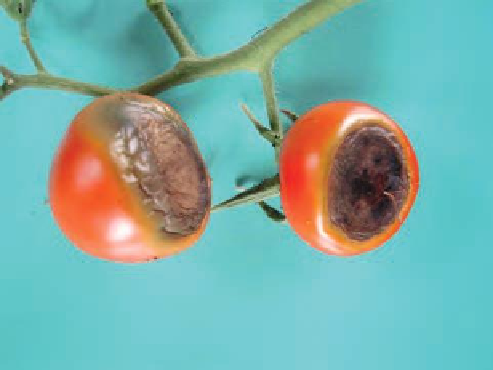Agriculture Reference
In-Depth Information
Figure 19.29
Blossom end rot
Figure 19.27
Effect of a low pH ericaceous compost
on
Salvia
spp. Note the stunted growth and blackened
main leaf veins
Figure 19.30
Bitter pit in apple fruit. Numerous
small brown spots appear on the fruit surface in late
summer
Blossom end rot (Figure 19.29) occurs on tomatoes
and peppers. It produces a symptom of a black,
concave lesion on the fruit that looks at first sight like a
fungal disease. It is caused by an imbalance between
potassium and calcium in the soil or compost. It occurs
most often when the soil or compost is allowed to dry
out while the fruits are swelling. It is seen more often
in greenhouse container-grown plants than in plants
growing in the open garden or greenhouse borders. It
is most common when plants are grown in grow bags,
where they have a small, shallow root run that dries
out easily. Although there is no cure for blossom end
rot once the symptoms begin to appear, the obvious
recommendation is that fruiting crops should never be
allowed to have dry roots.
Bitter pit in apples (Figure 19.30). Here the fruit
develop many small, dark brown, sunken pits.
The tissues below are stained to depth of about
19
Figure 19.28
Lime-induced chlorosis on raspberry.
Note the pale areas between the main veins
Nutrient deficiencies
Each nutrient (the most common being nitrogen,
phosphorus, potassium, calcium and magnesium) is
required in the correct amounts to enable the plant
to carry out its chemical processes. When nutrients
are present in too low amounts, deficiencies begin
to appear, usually showing as leaf symptoms (see
pp. 169-171). Care should be taken to provide regular
applications of a suitable fertilizer, especially during
the summer months and in situations where the roots
are restricted (as in pots). Two common gardening
problems should be noted.




